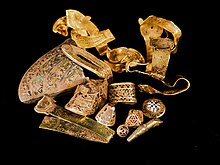Staffordshire Treasure
The treasure of Staffordshire is a hoard from the early Middle Ages .
The discovery of the find, which consists of more than 3,500 individual pieces and includes items made of gold with a total weight of more than five kilograms, was announced on September 24, 2009. After that is the treasure of Staffordshire the biggest has come to light hoard of Anglo-Saxon times . It can be dated to the 7th century AD.
discovery
The find was not recovered during an archaeological excavation, but by the probe Terry Herbert, who was looking near Lichfield on the field of a farmer friend, where he found the treasure on July 5, 2009. He notified the local monument preservation authority, and an excavation was carried out in the vicinity of the site. Selected pieces from the treasure were briefly exhibited in the British Museum in September 2009. The find was by the local coroner to the Treasure Act 1996 to the treasure ( Treasure explains). The finder and the landowner receive a corresponding reward, which is determined by the Treasure Valuation Committee together with the value of the fund .
In November 2012, a team of archaeologists found another 91 items about 100 m away from where the first items were found. 81 of these objects of various sizes have also been declared a treasure because they are more than 300 years old and have a precious metal content of over 10%.
Finds
There are around 3900 individual parts, including numerous objects made of gold and silver, but also copper objects. The finds include finely crafted silver and gold handles of swords and daggers , parts of grand helmets and two crosses. Many objects are provided with animal style ornaments, almandine inlays also appear.
Another object is a narrow strip of gold having a Latin inscription of the Numbers ( Num 10.35 VUL ): "surge d [omi] ne [et] disepentur inimici tui et qui Fugent oderunt te a facie tua" ( "Get up, Lord, then your enemies will disperse, / then your opponents will flee from you. ").
Most of the other finds are of a military nature and the gold stripe could have been attached to a shield or sword belt. There are no items that were typically used by women.
The finds have been cataloged and restored at the British Museum in London and are now on display at The Potteries Museum and Art Gallery in Stoke-on-Trent and the Birmingham Museum and Art Gallery in Birmingham .
meaning
The find has been compared to a new discovery of the Lindisfarne Gospels or the Book of Kells . Historians expect that knowledge gained from the treasure will change the view of Anglo-Saxon England just as radically or even more than the discovery of Sutton Hoo .
The original discovery of the treasure was made after the field was plowed, so there is no information on whether the items were originally buried in a trench or hole. There is no connection whatsoever that could explain why the treasure was buried here. There are suspicions that they were offerings at a shrine or other sacred place, as the objects were not buried at the same time.
literature
- Kevin Leahy, Roger Bland: The Staffordshire hoard. British Museum Press, London 2009, ISBN 978-0-7141-2328-8 .
Web links
- Official website (English)
- Staffordshire Hoard. In: Birmingham Museum and Art Gallery. (English).
- The Staffordshire Hoard. In: The Potteries Museum & Art Gallery. (English).
- Staffordshire Hoard. In: Current Archeology. October 12, 2010(English).
- The Staffordshire Hoard. In: Current Archeology. September 24, 2009(English).
- Lucia Marchini: Warrior treasures: Saxon gold from the Staffordshire Hoard. In: Current Archeology. February 2, 2017 (English).
- The Staffordshire Hoard. In: Flickr . (English, photostream).
- Huge Anglo-Saxon gold hoard found. In: BBC News . September 24, 2009.
Individual evidence
- ↑ Figure with notes on Commons
-
↑ Thorsten Huhn: Gold and silver excavated from the 7th century: the unemployed find the treasure of the Anglo-Saxons. In: tagesschau.de . September 24, 2009, archived from the original on August 21, 2010 ; accessed on July 5, 2019 . The Find. In: staffordshirehoard.org.uk. Archived from the original on July 3, 2011 ; accessed on July 5, 2019 .
- ^ Staffordshire Hoard inquest rules most new items treasure. In: BBC News . January 4, 2013, accessed July 5, 2019 .
- ^ Staffordshire Hoard: The Inscriptions. In: Current Archeology. September 24, 2009, archived from the original on July 20, 2012 ; accessed on July 5, 2019 .
- ↑ Maev Kennedy: Largest ever hoard of Anglo-Saxon gold found in Staffordshire. In: guardian.co.uk . September 24, 2009, accessed July 5, 2019 .
- ^ Matt Lee: Staffordshire Hoard: 'Opening a window into the Mercian kingdom'. In: BBC News. January 4, 2013, accessed July 5, 2019 .
Coordinates: 52 ° 39 ′ 19 ″ N , 1 ° 54 ′ 24 ″ W.
